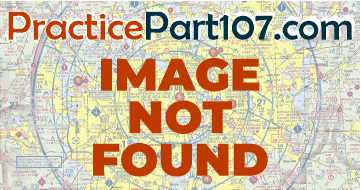FAA(Refer to FAA-CT-8080-2H, Figure 12.) The wind direction and velocity at KJFK is from
- ✅A:180° true at 4 knots.
- ❌B:180° magnetic at 4 knots.
- ❌C:040° true at 18 knots.

FAA-CT-8080-2H Figure 12 Area None - Click to enlarge.
Answer Figure

Click to enlarge answer figure
Explanations
- A: Correct. The METAR wind direction is based on true north. '18004KT' indicates wind from 180° true at 4 knots. This is a standard METAR format. Understanding wind direction and velocity is crucial for safe and efficient drone operations. Misinterpretation can lead to poor flight planning, increased battery consumption, and potential safety risks.
- B: Incorrect. METAR wind directions are reported in true degrees, not magnetic. Magnetic direction applies to ATIS or tower reports, not METAR. Misunderstanding this can lead to incorrect flight planning and potential safety hazards.
- C: Incorrect. 040° is not the reported direction; the METAR states 18004KT. Misinterpreting this information can lead to incorrect flight planning, increased battery consumption, and potential safety risks.
🧭 Instructor Note
Why This Matters for Your Business
Understanding and interpreting METAR reports, specifically wind direction and velocity, is crucial for operating a commercially successful drone business. Accurate interpretation can lead to efficient flight planning, optimal battery usage, and improved safety. Misinterpretation, on the other hand, can lead to potential safety hazards, increased operational costs, and reduced client satisfaction.
Safety & Liability Considerations
Correctly interpreting wind direction and velocity is crucial for maintaining safety and avoiding collision, damage, and injury. Misinterpretation can lead to poor flight planning, increased battery consumption, and potential safety risks. Additionally, it can lead to regulatory violations and potential fines.
Consider This Scenario
A drone inspection company is hired to conduct a detailed inspection of a large construction site. The company uses METAR reports to plan their flights. However, due to a misunderstanding of the wind direction and velocity data, the drone is flown in unfavorable wind conditions. This leads to increased battery consumption, reduced flight time, and incomplete inspection. The client is dissatisfied with the incomplete work and the company has to conduct additional flights, leading to increased operational costs and reduced profitability.
What the FAA is Testing
The FAA is testing your understanding of METAR reports, specifically how to interpret wind direction and velocity. This knowledge is crucial for safe and efficient flight planning.
Business Success Strategy
Ensure that all pilots in your operation are proficient in interpreting METAR reports, specifically wind direction and velocity. Regular training and practice can help improve accuracy and reduce the risk of misinterpretation. Use tools and resources, such as wind rose diagrams and METAR parsing tools, to aid in interpretation and flight planning.
Memory Aid
Remember that METAR wind directions are reported in true degrees, not magnetic. Live instructions (from tower or other pilot) is magnetic. Written in METAR is degrees true.
Enhanced References
- FAA Aeronautical Information Manual (AIM), Section 7-1-30: METAR
- FAA Advisory Circular AC 00-45H: Aviation Weather Services
- FAA Remote Pilot Study Guide, Section 1: Weather and Weather Effects
Related Concepts
- True vs. magnetic direction
- Wind interpretation in METARs
- Weather effects on flight planning
ACS Code: UA.III.A.K2
Difficulty: basic
